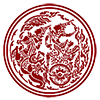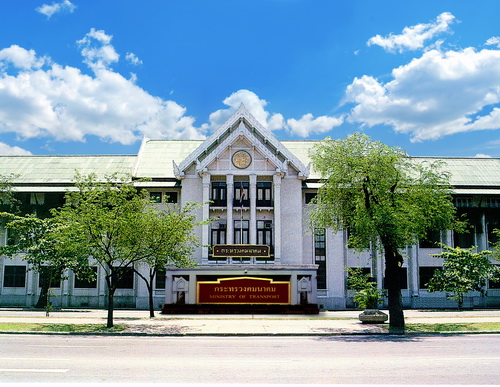- Home
- About MOT
About MOT
About MOT


- History
- Vision Mission
- Strategic Plan
- Executive
History of Transport
Transportation has long been high on the Kingdom’s agenda for sukhothai period through Rattanakosin Period especially in the reign of H.M. King Rama V who had played a crucial role in reforming the administrative system by establishing several new government agencies including the Department of Public Works that was in charge of transportation. This Department was founded by a royal command in B.E. 2432 (Bangkok Era 108) to make on-site inspection, construct buildings, build rods, dig canals, carry out and supervise the general skilled works, post and telegraph services as well railway service. A year later, all the agencies pertaining to public works in different ministries, the Post and Telegraph Department included, merged to create the Ministry of Public Works and H.R.H Prince KromKhun Naris sarnauwattiwongse. Director General, was appointed minister or “Senabodi”
In B.E. 2455 (Bangkok Era 131), by a royal command of H.M. King Vajiravudh (Rama VI) dated 27 March B.E. 2454, the Department of Public Works was renamed the Ministry of Communications on 1 April B.E. 2454 and Phaya Wongsanupapat (M.R. Sathan Sanitwongse) was appointed Senabodi in B.E. 2468. In the reign of H.M. King Prachadhipok (King Rama VII), the national trade had continued to prosper. On this account, King Rama VII made a royal command to amalgamate the Ministry of Communications with the Ministry of Commerce on 23 March B.E. 2468 and renamed the new authority as the Ministry of Communications and Commerce with the new Senabodi, H.R.H General Prince Khampaengphet Akkrarayothin. Later, the Ministry was renamed once again the Ministry of Commerce and Communications.
On 24 June B.E. 2475, Thailand underwent a change in system of government from an absolute monarchy to a constitutional form. Once again by a royal command of King Rama VII on 29 June B.E. 2475, the Ministry of Agriculture merged with the Ministry of Commerce and Communications and became the Ministry of Agriculture and Commerce.
In B.E. 2476 (1933), several revisions were made to the public sector regulations to respond to the current situation. All activities relating to transportation and telecommunication came under the Ministry of Economic Affairs.
In B.E. 2484 (1941), the communication sector was reorganized to become the Ministry of Communications and steadily received further modifications to its structure during the following years. It was not until B.E. 2545 (2002), that the Reorganisation of Ministries, Government Agencies and Departments, B.E. 2545 Act came into force. It stipulated that the Ministry of Transport (the former Ministry of Communications) would have overall responsibility for transportation, transportation – related business, traffic planning, and transport infrastructure development. At present, the Ministry of Transport is composed of the government administrations and the state enterprises as follows:
| Government Administrations | State Enterprises |
| 1. Office of the minister 2. Office of the Permanent Secretary 3. Marine Department 4. Department of Land Transport 5. Department of Civil Aviation 6. Department of Highways 7. Department of Rural Roads 8. Office of Transport Policy and Traffic |
1. State Railway of Thailand 2. Port Authority of Thailand 3. Mass Rapid Transit Authority of Thailand 4. Expressway & Rapid Transit Authority of Thailand 5. Bangkok Mass Transit Authority 6. Civil Aviation Training Center 7. Thai Airways international Public Company Limited 8. The Transport Company Limited Traffic 9. Airports of Thailand Public Company Limited 10. Thai Maritime Navigation Company Limited 11. Aeronautical Radio of Thailand Limited 12. Suvarnabhumi Airport Hotel Company Limited 13. THAI-AMADEUS Southeast Asia Company Limited 14. Airport Rail Link 15. Thai Smile Airways |
Vision
Develop an integrated transport system to improve the quality of life for all and drive Thailand 's sustainable economic.
Mission
1) Administer policy and drive strategy in an integrated manner in accordance with the direction of Thailand 's Development.
2) Improve and develop infrastructure and traffic management systems to meet current and future needs.
3) Supervise with good governance. Improve and develop legal systems and standards to keep up with changes.
4) Continually improve and develop the quality of transport service.
5) promote and support to create suitable value for transport system user and develop the ability to service provider.
6) Continually administer and develop the organization towards excellence.
Values
“I-SMART”
1) Inclusive
2) Safe,Securityand Sustainable
3) Multimodal Transport
4) Approachable
5) Reasonable Price
6) Timelyand Technology
Strategic Issues
1. The use of the transportation and traffic systems as a driving force for the economic strength and the status of transport and traffic hub in this region.
2. The sheer necessity of the public transport development to alleviate the acute traffic problems and raise the quality of life of people
3. The necessity to maintain the sufficient quantity and quality standards of the fundamental transportation services that will make the mass transport system more accessible for the public
4. The use of the transport system as a factor in pursuing strategies for particular area.
5. The more efficient use of the transport infrastructure system
6. Rising casualties as well as damage to property caused by transportation.
7. Awareness of the significance of the transport system for people’s quality of life and environment.
8. Awareness of the safety standard of transportation system.
9. The government’s straight forward policy on enhancing the efficiency of the government services and optimizing the capital investment and state asset.
Strategies of MOT
1. To increase the capacity for infrastructure system and efficient transport services to comply with the integrated strategy for development.
2. To build up and develop the extensive networks of mass transit system and public transport services for both passengers and goods, to offer equal opportunities to travel to the public and act as a catalyst for the sustainable development of the country.
3. To streamline the existing transport network. 4. To ensure public safety of transport system, lessen its environmental impact, enhance the quality of life of people and minimize the economic loss.
5. To maximize the potential for good governance and systematic monitoring with the public participation in making and inspection so as to raise the quality of public transport services.
Office of the Minister
According to the ministerial Regulations on the Organization of the office of the Minister, B.E. 2545, this agency is in charge of arranging political affairs, in support of the minister’s tasks and working in conjunction with other ministries in regard to policy. The responsibility of the Office of the Minister is the following:
1. To gather, analyze information and submit recommendations to the Minister for consideration.
2. To assist the Minister on political affairs and cooperate with other ministers, the cabinet, the Parliament and Parliament and public.
3. To deal with the process of replying to the questions in parliament, to make preparations for the discussion of the motion, draft act and other political issues in the parliament.
4. To take complaints, claims, petitions or requests submitted to the Minister into consideration.
5. To perform and other duties as stipulated by law or delegated by the minister or the Cabinet.

Suriya Juangroongruangkit
Minister of Transport

Manaporn Charoensri
Deputy Minister of Transport

Surapong Piyachote
Deputy Minister of Transport

 TH
TH Sign In
Sign In 
 Go :
Go :